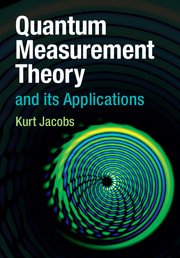Book contents
- Frontmatter
- Dedication
- Contents
- Preface
- 1 Quantum measurement theory
- 2 Useful concepts from information theory
- 3 Continuous measurement
- 4 Statistical mechanics, open systems, and measurement
- 5 Quantum feedback control
- 6 Metrology
- 7 Quantum mesoscopic systems I: circuits and measurements
- 8 Quantum mesoscopic systems II: measurement and control
- Appendix A The tensor product and partial trace
- Appendix B A fast-track introduction for experimentalists
- Appendix C A quick introduction to Ito calculus
- Appendix D Operators for qubits and modes
- Appendix E Dictionary of measurements
- Appendix F Input–output theory
- Appendix G Various formulae and techniques
- Appendix H Some proofs and derivations
- References
- Index
4 - Statistical mechanics, open systems, and measurement
Published online by Cambridge University Press: 05 September 2014
- Frontmatter
- Dedication
- Contents
- Preface
- 1 Quantum measurement theory
- 2 Useful concepts from information theory
- 3 Continuous measurement
- 4 Statistical mechanics, open systems, and measurement
- 5 Quantum feedback control
- 6 Metrology
- 7 Quantum mesoscopic systems I: circuits and measurements
- 8 Quantum mesoscopic systems II: measurement and control
- Appendix A The tensor product and partial trace
- Appendix B A fast-track introduction for experimentalists
- Appendix C A quick introduction to Ito calculus
- Appendix D Operators for qubits and modes
- Appendix E Dictionary of measurements
- Appendix F Input–output theory
- Appendix G Various formulae and techniques
- Appendix H Some proofs and derivations
- References
- Index
Summary
We now turn to the subject of thermodynamics, and to describing the process of thermalization of quantum systems. A quantum system that interacts with another system large enough to obey the usual rules of thermodynamics, is referred to as an open system. The thermal system with which it interacts is often referred to as a thermal bath, or simply as the environment. We will use these terms interchangeably. Modeling the behavior of open quantum systems has many applications. One of these is to model the noise that they are subjected to by their surroundings, noise that we will wish to control using measurement and feedback loops in Chapter 5. There are also two important connections between quantum measurements, information theory, and thermodynamics. The first of these is that the thermodynamic entropy of a macroscopic system can be identified with the information-theoretic entropy that characterizes the lack of knowledge of an observer about the microstates of the system. In turn, if an observer is allowed to make microscopic measurements on the system, then this modifies the thermodynamic rules regarding the conversion of heat to work. Such is the subject of Maxwell’s demon. Curiously it took more than a century to understand how Maxwell’s demon, essentially a microscopic measurement and feedback process, fits within the second law of thermodynamics. In another twist, it turns out that the process of erasing information requires an increase in the thermodynamic entropy of the environment, and this increase is directly related to the amount of information erased.
- Type
- Chapter
- Information
- Quantum Measurement Theory and its Applications , pp. 160 - 231Publisher: Cambridge University PressPrint publication year: 2014



